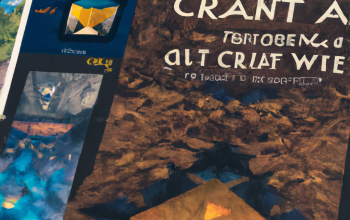Once upon a time, in a realm far beyond the constraints of reality, imaginative worlds materialized, inviting eager gamers to embark on extraordinary adventures. These game worlds, made possible by the fusion of art and technology, have transformed the landscape of gaming, capturing the hearts and minds of players across the globe. In this ethereal domain of pixels and polygons, where innovation knows no bounds, artistic expression emerges as a formidable force, shaping immersive gaming environments that blur the lines between fantasy and reality. Join us as we delve into the enchanting realm of crafting creative game worlds and unravel the secrets behind their awe-inspiring landscapes.
Designing a Dream: The Role of Visual Artistry in Game World Creation
Visual artistry plays a pivotal role in the creation of captivating game worlds that transport players into a realm of imagination and wonder. It is the brushstroke that brings the virtual environment to life, shaping everything from the landscapes and architecture to the characters and creatures that inhabit them. Through intricate designs and attention to detail, artists have the power to evoke emotions, spark curiosity, and immerse players in an unparalleled gaming experience.
In the realm of game world creation, visual artistry serves as a powerful storytelling tool. It allows game developers to craft narratives, establish atmospheres, and convey the essence of a world through carefully selected color palettes, textures, and visuals. Whether it’s a post-apocalyptic wasteland, a mystical realm of magic, or a futuristic metropolis, each game world is a testament to the creativity and talent of the visual artists behind it. From concept art and character design to environmental rendering and visual effects, every brushstroke contributes to the visual identity and overall aesthetic of the game, ensuring its uniqueness and its ability to captivate players.
- Mastery of Perspective: Visual artistry in game world creation requires a deep understanding of perspective and composition. It involves meticulous calculations to create realistic depth and proportions, ensuring that players feel fully immersed in the virtual realm.
- Creating Atmospheric Ambiance: Artists meticulously craft lighting, shadows, and color schemes to establish the mood and ambiance of a game world. From vibrant and colorful to dark and foreboding, each environment elicits specific emotions and sets the tone for the player’s journey.
- Character and Creature Design: Visual artists breathe life into the virtual inhabitants of game worlds, designing characters and creatures that are visually compelling and reflective of the game’s narrative. From heroic protagonists to fearsome monsters, each character is meticulously sculpted, textured, and animated to enhance the overall gaming experience.
In conclusion, the role of visual artistry in game world creation is of paramount importance. It spans beyond mere aesthetics, seamlessly intertwining with storytelling and gameplay to create immersive, breathtaking experiences. From breathtaking landscapes to enchanting characters, the visual artistry behind game worlds sets the stage for players to embark on unforgettable adventures, leaving an indelible mark in the realm of gaming.

Unleashing Imagination: The Power of Narrative in Crafting Immersive Gaming Environments
When it comes to creating immersive gaming environments, the power of narrative cannot be underestimated. While stunning graphics and realistic gameplay mechanics certainly contribute to the overall experience, it is storytelling that truly captivates and engages players, transporting them to fantastical realms and captivating adventures. By weaving compelling narratives into game design, developers have the incredible ability to unleash the full potential of players’ imaginations.
One of the key elements that make narrative such a potent tool for crafting immersive gaming environments is its ability to provide context and purpose. Through a well-developed story, players are not only given a reason to explore the virtual world but also to emotionally invest in the game’s characters and their journey. These narratives act as guiding threads, offering direction and motivation while allowing players to develop a deeper connection to the game. A well-crafted narrative can grasp players’ attention and maintain their engagement, culminating in an experience that goes beyond simple entertainment.
- Unlimited possibilities: Narrative-driven gaming environments are boundless, free from the constraints of reality. Within these virtual landscapes, players can become anything and go anywhere, completely immersing themselves in the realm of imagination.
- Empowering the player: By placing players at the center of immersive narratives, gaming environments empower individuals to shape their own destinies and make meaningful choices. The impact of decisions made within the narrative can provide players with a sense of agency and control.
- Creating emotional connections: Memorable characters, intricate plotlines, and unexpected twists all contribute to the emotional depth of a narrative-driven gaming environment. These elements invest players emotionally, enriching their gaming experience and leaving a lasting impact.
Mastering the Fine Balance: Blending Aesthetics and Functionality for Interactive Experiences
In the ever-evolving world of interactive experiences, finding the delicate equilibrium between aesthetics and functionality is truly an art form. It requires a blend of creativity, technical expertise, and a deep understanding of user psychology. When designing interactive experiences, every decision must be carefully crafted to captivate and engage users while seamlessly serving a purpose.
To create truly unforgettable interactive experiences, designers must go beyond surface-level aesthetics and dive into the realm of functionality. This involves striking a harmonious balance between visual appeal and practicality, ensuring that the final product not only looks stunning but also delivers a seamless and intuitive user experience. By carefully considering the needs and expectations of the target audience, designers can shape interactions that not only captivate and inspire but also provide genuine value.
When designing for aesthetics and functionality, it is crucial to pay attention to the smallest of details. From the choice of typography and color palette to the placement of interactive elements, every component plays a vital role in enhancing the overall user experience. By harnessing the power of HTML and CSS, designers can create visually stunning interfaces while maintaining optimal functionality. Elements like coherent navigation menus, intuitive user flows, and responsive design are essential ingredients that contribute to the overall success of an interactive experience. To master the fine balance between aesthetics and functionality, it requires not only a keen eye for design but also a deep understanding of human behavior and technology. Only then can the true magic of interactive experiences be unlocked and shared with the world.
A Palette for Success: Techniques and Strategies for Creating Unique and Compelling Game Worlds
Welcome to the realm of game design where imagination knows no bounds! In this section, we will explore a myriad of techniques and strategies that will help you craft breathtaking game worlds that captivate players. So, grab your virtual paintbrush and let’s get started on this epic journey of creation.
1. **Setting the stage with immersive storytelling:** Begin by establishing an intricate plot that seamlessly weaves together characters, conflicts, and lore. Think about the game’s history, geography, and even politics to breathe life into your world. By building a narrative that resonates with players, you will transport them to a realm where they can be fully immersed in the story.
2. **Designing awe-inspiring landscapes:** Infuse your game world with visually stunning landscapes that leave players awestruck. Think beyond the conventional and dare to create environments that defy gravity, logic, and expectations. From celestial realms floating amidst vibrant nebulas to mystical underwater kingdoms, let your creativity flourish in shaping breathtaking vistas that players will remember long after they have put down their controller.
In Conclusion
As we bid farewell to this deep dive into the enchanting realm of crafting creative game worlds, we come away with a profound appreciation for the power of artistic expression in shaping immersive gaming environments. Through the strokes of a digital brush and the deft manipulation of pixels, game developers create universes that transport us from the mundane to the extraordinary.
In this article, we explored how the unique blend of creativity and technology ignites the imagination, weaving intricate narratives and building sprawling landscapes that captivate our senses. The marriage of art and gaming has birthed breathtaking vistas, labyrinthine dungeons, and characters that resonate deep within our souls.
From awe-inspiring blockbusters to indie darlings, the landscape of gaming has been enriched by the boundless possibilities for artistic expression. We’ve witnessed the transformative power of whimsical aesthetics in games like “Journey,” where the desert becomes a canvas for the most ethereal of narratives, and the minimalist elegance of “Limbo,” reminding us that beauty can be found even in the darkest corners.
Yet, as we look ahead, we must also consider the responsibility that comes with crafting game worlds. With the potential to shape our perceptions and attitudes, the choices made by game developers can possess significant impact. How they depict diversity, address social issues, or challenge stereotypes shapes not only our immersion but our understanding of the world around us.
In the end, the artistry of game development connects us all. It transcends language barriers and bridges cultural divides, providing a collective experience that unites gamers from every corner of the globe. It is through the magic of artistic expression that we find solace, joy, and inspiration within these immersive gaming environments.
So as we venture forth into new worlds that have yet to be imagined, let us celebrate the creative minds who dare to dream and the painstaking craftsmanship that brings these visions to life. For in their hands lies the power to whisk us away on unforgettable journeys, forever leaving their mark on gaming history.
May the games we play continue to be enriched by the splendor of artistic expression, guiding us through a world where creativity knows no bounds, and imagination reigns supreme. And as we embark on the next chapter of gaming, we bid adieu, knowing that this is just the beginning of an ever-expanding tapestry of boundless creativity in the realm of game worlds.
The concept of game worlds has captivated gamers for decades. The games we play become living, breathing immersive environments that have the potential to transport us to worlds unknown. As a result, an understanding and appreciation of the craft of game art helps gamers to appreciate the way these worlds have been crafted.
The concept of creative game art and design has been continuously evolving over the years. What began as mere sprites in the arcade games of the early 1980s have been replaced with sumptuous, highly-textured digital scenes of awe-inspiring beauty. From cute and cuddly animal heroes to post-apocalyptic wastelands, concept and lead artists work hand-in-hand with game designers, engineers, audio teams, and producers to create depth, atmosphere, and engaging stories.
When artistry and technology combine, game worlds become incredibly vivid and realistic. Game artists must constantly research, experiment, and innovate to keep up with the latest advancements in graphics technology. Whether it’s the choice of texture, color palette, or lighting, these thoughtful decisions add to the atmosphere and create a sense of wonder. Imagery and symbolism often appear, giving the player personality and credibility amongst a group of characters.
On top of artistry, gamers also appreciate the story-telling possibilities of game worlds. By designing missions and objectives, game designers create immersive gameplay, allowing gamers to feel like a part of the world they explore. This concept of a living, breathing world is further enhanced by background audio and sound effects, which builds the tension and lends reality to the game world’s inhabitants.
The artistry and storytelling that goes into creating game worlds cannot be understated. By keeping up with the latest technologies and understanding the psychology of storytelling, game developers are able to craft immersive, beautiful digital worlds, ensuring the longevity of the gaming industry. Whether it’s the immense lands of RPGs or the frenetic action of racing games, a passion for artistry and imagination remains the driving force behind the creation of these spectacular and imaginative gaming environments.



